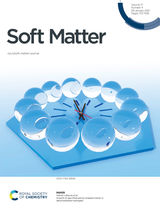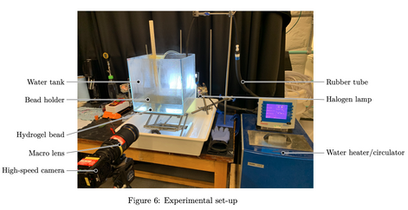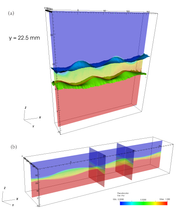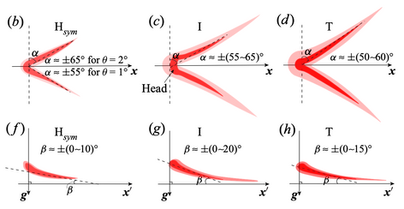
Past projects
Below is a list of selected past research projects and results in reverse chronological order, with an image and video gallery that emerged from each. For more details, check out my publications.
Project 6 (2022-2024)
Data-driven discovery of the 'flavours' of stratified turbulence from experimental shadows
Some experiments in fluid mechanics produce large datasets, making it difficult for humans to extract useful patterns that enhance our physical understanding. This is especially true in the Stratified Inclined Duct experiment, introduced below in Projects 2-4, from which hundreds of long movies have been recorded over the years using the 'shadowgraph' technique. This technique relies on the difference between refractive index in waters of different salinities to cast shadows on a screen that reveal deep information about the inner structure of turbulent mixing within the duct. This project focused on a recent dataset of >100 high-quality shadowgraph movies shown on this page. These movies contain valuable information about how turbulence evolves as the subtle balance of forces within the flow changes between experiments, quantified by the Reynolds number and the tilt of the duct.
The challenge we overcame in (Lefauve & Couchman, 2024) was to identify insightful patterns from such a large dataset using a novel automated computational technique that carefully reduce the dimensionality of the data (from megapixel images to a two-dimensional vector) while keeping meaningful physics, before clustering this data with an algorithm routinely used in data science. This technique was superior than the human eye (faster, more objective and robust) and revealed surprisingly clear 'clusters' of images where the density interfaces embedded in the flow (shown by the shadows) had similar morphology, which we can interpret as giving a certain 'flavour' of turbulence, with particular mixing properties. The clustering also revealed insights into how these flavours gradually evolved with the governing parameters.
In a subsequent paper (Lefauve, Cheung, Jiang & Couchman, 2025) we leveraged this technique to make progress on a particularly interesting 'intermittent' regime where the flow cycles between laminar and turbulent states, as is common in many environmental flows. We discovered two different routes to stratified turbulence and developed a cluster-based 'network model' of intermittency that quantified transition probabilities and residence times under increasing turbulence. Our method and results paved the way for new reduced-order models of multi-physics turbulence, and more broadly, for the efficient compression and interrogration of big experimental, computational, and field data, which I am keen to explore.
Project 5 (2020-2023)
Giving hydrogels 'the bends': a new mechanism for decompression sickness
The idea behind this project came from my passion for scuba diving. Decompression sickness is a serious medical condition limiting the practice of scuba diving, caused by the uncontrolled release of dissolved air into bubbles in the body after resurfacing. My motivation was to better understand this condition by studying its fundamental mechanics. Bubbles in soft tissues (for example joints, muscles, skin, nerves) are poorly understood compared to bubbles in liquids (for example blood), despite causing the most frequent symptoms (articular, muscular, and cutaenous pain, as well as paralysis if it takes place in the spinal cord). This project materialised in 2020 into the mathematical modelling of bubble growth in soft, brittle solids, which, unlike liquids, oppose a subtle elastic resistance and can fracture irreversibly (or ‘crack’). The interplay between gas diffusion, growth, solid deformation and cracking results in a complex but scientifically fascinating problem, with tangible applications, including the safer practice of recreational and professional diving.
I chose to use hydrogels (a `solid' gel made of 99% water and 1% polymer!) to mimic body tissues. Multiple undergraduate students worked on this challenging problem both experimentally and theoretically. Our first paper (Zhang, Etzold & Lefauve, 2021) proved that millimetric gas bubbles can grow catastrophically by cracking the surrounding tissue, which had never been reported. Experiments managed to map and track the 3D shape of growing cracks inside the hydrogels, attracting the front cover of Soft Matter, and a news story in the APS Physics magazine.
We are currently trying to gain a better understanding of how these dangerous cracks may develop from tiny gas pockets, to help predict the conditions leading to pathology. The most recent experiments employed high-speed imaging of micrometric cavities, producing tantalising data, but a predictive mathematical model remains elusive. This research problem and its potential implications would make for an exciting future PhD project!
Project 4 (2019 - 2024)
Quantifying energy dissipation and mixing in stationary, sheared stratified turbulence
One of the unique features of the stratified inclined duct (SID) experiment is that it contains the four key flow regimes observed in Nature: laminar flow, Holmboe waves, intermittent patches of turbulence, and eventually full turbulence. Much of my effort during my PhD and since has been devoted to the long-standing question: how do we explain and predict the successive transitions to increasingly turbulent regimes? This question is significant for fluid mechanics and the study of the transition to turbulence as a whole, because it is now accepted that SID is a relatively recent canonical flow with a wealth of fundamental transitional behaviours on which much remains to be understood.
A first milestone was the development of a hierarchy of simplified mathematical models to connect these transitions to thresholds in kinetic energy dissipation (Lefauve, Partridge & Linden, 2019). I then built on this framework to tackle turbulent mixing with a further dataset collected from 886 individual experiments spanning a multi-dimensional parameter space which improved upon decades of previous research (Lefauve & Linden, 2020). My datasets, which I always make publicly available, have been used by other groups, who explored applications to estuary flows. We also undertook a comprehensive statistical analysis of my previous 16 ‘state-of-the-art’ datasets from a multitude of viewpoints that speak to the experimental, computational, and observational communities (Lefauve & Linden, 2022a, 2022b). These papers touches on the self-organisation of turbulence, on its parameterisation using turbulent diffusivities, on mixing efficiency, and on the hierarchy of lengthscales in statistically stationary, shear-driven, stratified turbulence.
These results were then summarised and put in their historical context in a review (Lefauve, 2024), which also highlights the future exciting questions to answer and technical challenges to overcome. We are now trying to understand the links between 3D coherent flow structures uncovered in Project 3 and the turbulent statistics uncovered in this Project 4. A key outstanding question we are working on is: how can we link the morphological evolution of increasingly turbulent vortical and shear structures to increasing rates of turbulent production, buoyancy flux, dissipation and mixing?
Project 3 (2017 - 2023)
Uncovering the morphology of three-dimensional coherent structures in stratified turbulence
Using the technology from Project 2, we uncovered experimentally and explained a new three-dimensional flow structure called a ‘confined Holmboe wave’ (Lefauve et al. 2018). Holmboe waves are oscillations found in oceans and estuaries, which transport energy and mass along and across fluid layers, and which can grow unstable and trigger more vigorous mixing. We explained how the classical Holmboe instability was modified in narrow rivers channels or deep-ocean trenches which severely confine the flow laterally. The agreement between a three-dimensional stability analysis and the experimental data was astounding and significant enough to be recognised by multiple prizes and awards, including a 'Focus on Fluids' from the Journal of Fluid Mechanics, a Young Scientist Award from the European Mechanics Society, and a Silver Medal for Mathematics from the UK Parliamentary and Scientific Committee.
This work spurred a MSc project with F. Gallaire's group at EPFL Lausanne to investigate more systematically the effects of confinement (Ducimetière et al. 2021) and an undergraduate project on weakly nonlinear Holmboe waves to explain how these waves saturate to a finite (experimentally visible) amplitude. We developed and implemented numerically a weakly nonlinear expansion to answer this question and provide a foundation for future fully-nonlinear work (Cudby & Lefauve, 2021). We also collaborated with G. A. Lawrence' group at UBC Vancouver on fully-nonlinear simulations of Holmboe waves, allowing for comparison with experiments. We focussed on the effects (or "feedback") that these waves have on the background flow through Reynolds stresses, which are central to modelling environmental flows (Yang et al. 2021).
In more recent papers (Jiang et al. 2022, 2023) we looked at the evolution of coherent vortical structures under increasing turbulence intensity, using the 16 state-of-the-art 3D datasets from Project 2. We have been able to track the how the morphology of vortices and shearing structures evolve from confined Holmboe waves to give rise to characteristic hairpin vortices, which had never been observed in stratified flows in the laboratory. This allowed to gain new insight into how vortices combine to stir and mix the density field in previously unsuspected ways, and our 2022 paper was highlighted by a Focus on Fluids in the Journal of Fluid Mechanics.
Project 2 (2015 - 2024)
Probing stratified turbulence with cutting-edge experimental and computational diagnostics
To better address the ocean mixing challenges revealed by Project 1, my PhD and postdoctoral research have then moved towards a more fundamental and experimental study of stratified turbulence. Until recently, data-rich laboratory experiments were lacking because no diagnostics were capable of measuring three-dimensional, density-dependent, small-scale turbulence, and no laboratory flow could sustain for long time periods the high levels of dissipation found in Nature. I made such experiments possible by applying state-of-the-art diagnostics to a new, highly-dissipative, canonical stratified shear flow, the Stratified Inclined Duct (abbreviated 'SID').
The new methodology, originally developed in DAMTP by S. B. Dalziel, uses three high-speed cameras and a fast-scanning laser sheet. It allows to measure the full three-component velocity and density fields in successive two-dimensional planes, which are then combined into volumes (Partridge, Lefauve & Dalziel, 2019). We obtained 16 datasets of unprecedented quality, which you can visualise on this page, and which allowed us to develop the next two projects. These measurements are still being refined today in the G. K. Batchelor Lab to keep pushing the boundaries with the latest laser and high-speed camera technology.
With colleagues A. Atoufi and L. Zhu we have now also developed direct numerical simulations (DNS) of the flow in the SID (Zhu et al. 2023) which have been validated by the experiments, showing an excellent agreement which is rare enough in fluid mechanics to be highlighted. Numerical datasets have allowed us to diagnose inacessible variables such as pressure all along the duct (Atoufi et al. 2023). More recently, we have also shown that physics-informed neural networks (PINN) could help us augment the resolution experimental data and provide new insights (Zhu et al. 2024). Applying such PINN techniques to turbulent datasets would be the next breakthrough.
Project 1 (2014-2015)
Estimating internal wave dissipation in the deep ocean using global datasets
My fascination with ocean mixing started during my MSc at Ecole Polytechnique, and keeps providing the underlying motivation for my more recent projects. In the paper (Lefauve, Melet & Muller, 2015) we tackled the turbulent dissipation of internal gravity waves generated by tides interacting with the rough seafloor in the deep, stably-stratified ocean (below the thermocline). From the seafloor these waves propagate upwards, transporting their energy, and steepening as they encounter increasing stratification. This can cause these waves to break turbulently, dissipating kinetic energy, and mixing the surrounding waters in sometimes highly-localised regions. This mixing is a critical component of the climate system as it sustains the large-scale overturning circulation of the oceans, directly affecting the global transport of heat and carbon.
We produced three-dimensional worlwide maps of energy dissipation, a good proxy for mixing rates, by combining linear and nonlinear theories (for the wave generation, propagation, and breaking) with three global datasets: small-scale bathymetry spectral data, tidal data (from satellite altimetry) and stratification data (from Argo floats). We showed that more energy was dissipated near mid-ocean ridges in the Southern Hemisphere and that it was dissipated higher up in the water column than previously thought. We also proposed a simple method to include these results in global ocean models to improve their predictive power.






























































































